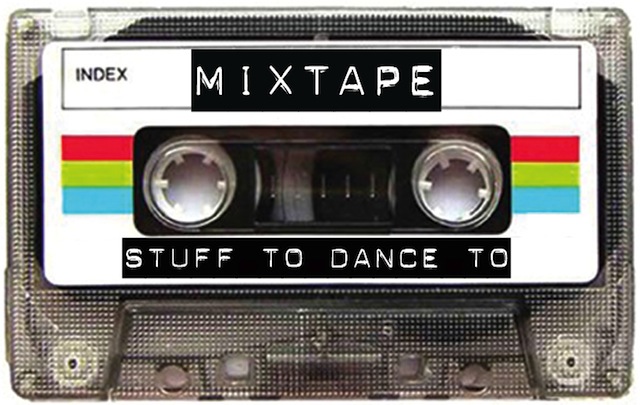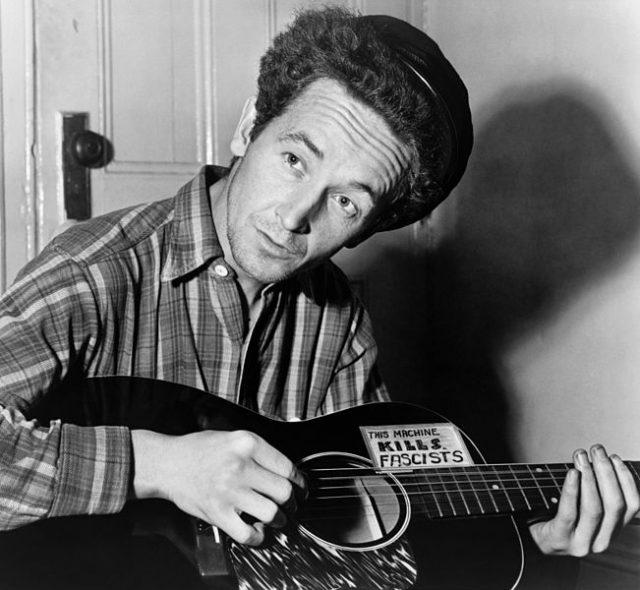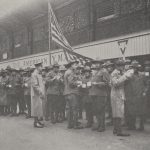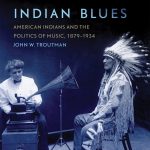By Eyal Weinberg and Blake Scott
It’s midway through the semester and you’ve slogged through one of the infamous central Texas morning monsoons to make it to class. You’re soaked and so are the students starting to arrive. And you’re all a bit stressed from the commute and all the other work still floating in your head. You organize your lecture notes. More students start to come in. Some sit quietly. Some stare at you. Some are glued to their mobile devices. There are still about 10 minutes before class begins. We call it the awkward pre-lesson moment. You could warm up the wet early birds with some tough words of inspiration, or you could do what we tried this semester: lure the students into history with the power of music.
Today’s subject is the Great Depression and the New Deal. In the time that ticks off before class, as your clothes dry and you review your notes, Bing Crosby sings “Brother can you spare me a dime?” The song is a sad anthem of the early 1930s. It’s as if Crosby were singing not only to an earlier generation, but also to your rain-drenched grumpy students. In between lyrics, you remind the class to also review their notes.
Next is a more upbeat song by Louis Armstrong, “WPA,” released in 1940. Armstrong sings, “The WPA, WPA…. Three letters that make life OKAY, the WPA.” When the song ends, you start class, asking “so what exactly was the WPA and how did it fit into the New Deal’s efforts to relieve the stresses of the Great Depression?” Discussion has begun and, with melody replacing drudgery, you’re ready to tackle some difficult historical topics – the melancholy of depression and the changing role of the federal government. Music has set the mood.
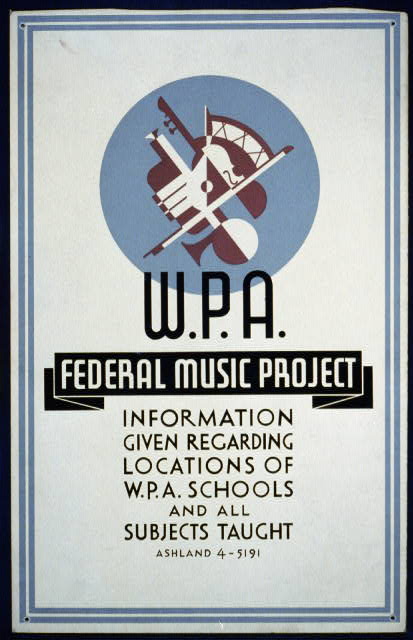
The Works Progress Administration’s music project employed
musicians as instrumentalists, singers, concert performers, and music teachers during the Great Depression. Via Library of Congress.
We are not specialists in music history, but we value what music can do in the classroom. Every Friday last Fall semester, we facilitated discussion sections with approximately 30 students each. As teaching assistants, we offered supplemental instruction for Dr. Megan Seaholm’s 300-person lecture on the history of the United States from 1865 to the present. On Fridays, in smaller groups, we discussed course material and, in particular, encouraged students to think about questions of ethics in relationship to historical events. The seminar meetings fulfilled UT’s “Ethics and Leadership Flag,” which is designed to equip students with “the tools necessary for making ethical decisions in your adult and professional life.” When discussing the period of Reconstruction, for example, we examined differing visions of “freedom.” We analyzed primary source documents written by newly freed slaves, white southerners, and northern Republicans. How did different social groups conceive of freedom, and how did their values clash and in turn, shape post-war U.S. society?
Music, we soon realized, could be an effective prompt for encouraging students to think creatively and critically about material that at times felt historically distant. Playing and then thinking about music had a broad classroom appeal. It allowed us to consider experiences from an earlier era in a very direct and affective way. Getting students to listen closely, and reflect on historical attitudes, was smoother and even enjoyable. This was certainly useful when teaching history to students from different majors who admittedly took the course only because it was a requirement. At the beginning of the semester, we heard more than enough talk about how “I’ve never been very good at history.” That only motivated us more…
To remind students that the issue of race was central to the era of Reconstruction (1865 to 1876), we paused discussion and played Pete Seeger’s version of “John Brown’s Body.” It was a chance to consider the causes and effects of the Civil War and its continuing affect on U.S. society. The song led to an anecdote: After Union Troops burned Atlanta in November 1864, they marched out of the city singing, “John Brown’s body lies a-mouldering in the grave… but his soul goes marching on.” It became a favorite song among General Sherman’s troops as they marched to the sea from Atlanta to Savannah, Georgia. The song also encouraged us to explore the controversial legacy of the abolitionist John Brown. Ralph Waldo Emerson claimed that “[John Brown] will make the gallows glorious like the Cross.” Thoreau also wrote a eulogy for Brown, explaining that in death: “He is more alive than ever he was.” The point of this brief genealogical thread about a man and a song was to acknowledge that the Civil War was fundamentally about slavery. After the war, the legacy of racism would continue to shape the debate about the meaning of freedom.
Later in the semester, to guide a discussion about the Civil Rights Movement, we played Nina Simone’s “Mississippi Goddam.” Hearing Simone sing, with anger and passion, “Alabama’s gotten me so upset, Tennessee’s made me lose my rest, and everybody knows about Mississippi goddam,” reminded students to seriously contemplate the violence that occurred in the U.S. South in the 1960s. The song opened a discussion about the KKK’s terrorist bombing in Birmingham, which Simone refers to, and in contrast, the early Civil Rights Movement’s commitment to nonviolent protest.
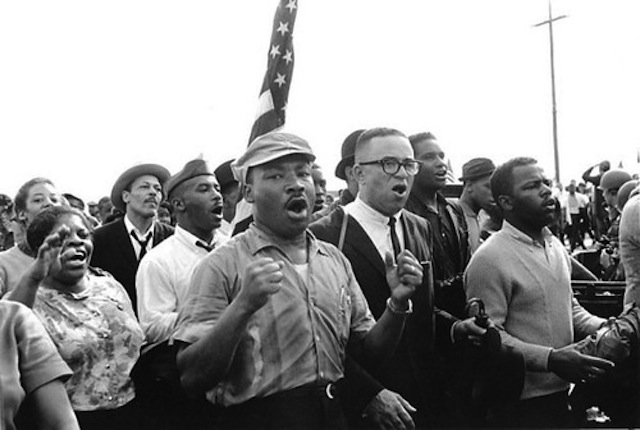
Martin Luther King Jr. and Civil Rights activists singing Freedom
songs on the Selma to Montgomery March in 1965. Via Jacobin magazine.
Music served as primary source material to think about the time and to feel something of the era. We asked students to imagine the power of John Brown’s song being sung by Union soldiers marching through Georgia, and later, to reflect on the violence and injustice swirling around civil rights activists marching from Selma to Montgomery. These are powerful images to consider with an equally powerful soundtrack to hear and feel. With story and song together, students were forced to reckon with the material and its importance to U.S. history.
As we soon learned, however, not all classroom experiences have to be so tightly scripted. Music as pedagogical tool can take on a more implicit role as well. It can literally “set the mood” for the class and help foster a space for dialogue. As our experience this semester taught us, music can be a way to hear and feel history, to jump start conversation or frame a question, and most importantly, to bring people together. Even if students are not asked to analyze a song’s lyrics or the story of its production, music can still affect a student’s reception of history. Songs can also work in mysterious ways.
If you appreciate music and recognize that songs can also serve as an important resource for teaching history, we encourage you to share your own musical selection down below in the comments. What songs would you play in a post-civil war US survey? Here is our own highly subjective “History Mixtape” to start the exchange. We hope to hear and learn from your recommendations. Keep the music playing…
Our History Mixtape:
- John Brown’s Body by Peter Seeger
- The Battle is Over (But the War Goes On) by Brownie McGhee & Sonny Terry
- This Land is Your Land by Woody Guthrie
- Fire in the Hole by Hazel Dickens
- Brother can you spare me a dime? by Bing Crosby
- WPA by Louis Armstrong
- Everyday by Buddy Holly
- Mississippi Goddamn by Nina Simone
- Fortunate Son by Creedence Clearwater Revival
- I-Feel-Like-I’m-Fixin’-To-Die Rag by Country Joe McDonald
We are always keen to build our playlist so please send us your recommendations via the comments section on our facebook page.
You may also like:
- Lomax Family Collections at the American Folklife Center
- The Library of Congress, American Memory Collection
- The University of Houston’s Digital history music database
- University of Pittsburgh’s Voices Across Time database, divided into periodic and thematic categories
